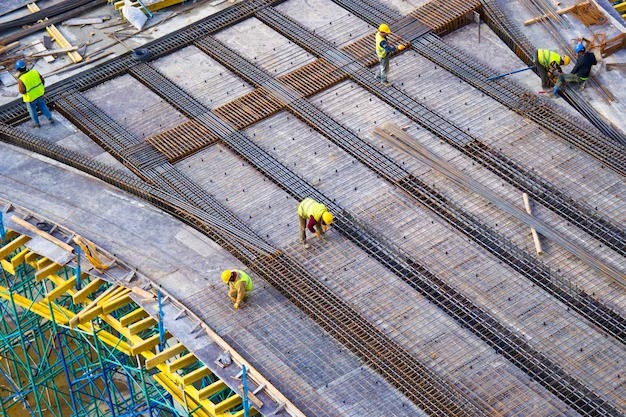
Ever looked at a skyscraper and wondered, “How on earth does it stay upright?” Or perhaps you’ve been in the midst of a house renovation and heard the term ‘footing’ thrown around. Well, you’re in the right place to demystify the world of construction footings. Strap in, and let’s dive deep (literally) into the foundation of all things construction.
Footing 101: What Exactly Is It?
Alright, let’s start simple. Imagine you’re building a sandcastle. Before crafting those tall towers and intricate gates, you’d first create a solid base, right? That base ensures your castle doesn’t topple over. In the world of construction, this base is known as the ‘footing’.
In technical terms, footings are structural elements that support and distribute the load of the building to the underlying soil or rock. They act as intermediaries, spreading out the weight to prevent the building from sinking or settling unevenly.
Different Strokes for Different Folks: Types of Footings
Just as there are different types of buildings, there are various footings to suit different needs.
Strip Footing:
This is like a continuous strip running under the wall to spread its weight. Think of it as the long base of your sandcastle.
Pad Footing:
These are isolated bases that support individual columns. Picture the base of a single tower in your sandcastle.
Pile Footing:
When the topsoil isn’t sturdy enough, we drive deep columns (piles) into the ground until they reach a more solid layer. It’s like placing stilts on a house in the swampy areas.
The Footing’s Role in Stability and Safety
Ah, the unsung hero of construction: the footing! If footings could talk (or sing, for that matter), their anthem would surely be, “Steady as she goes!” These foundational champs are all about stability. Let’s break down their pivotal roles a bit further:
Weight Distribution:
Think back to your childhood when you first learned the magic of weight distribution with that book-on-bed experiment. Placing a hefty book on a plush bed often leads to an unmistakable dent. However, spread that book’s weight over a broader surface, like with a sturdy plank, and that dent magically disappears. In the world of towering skyscrapers and cozy homes, footings play this essential role. They spread the building’s weight uniformly, preventing undue pressure on any particular area. This ensures that the structures we adore don’t sink or tilt over time.
Dealing with Mother Nature:
As much as we’d like to predict her moods, Mother Nature has a knack for surprises. From the jolting tremors of earthquakes to the erosive force of floods, our beloved constructions have to withstand a lot. And oh, let’s not forget the freeze-thaw cycles in those chilly regions, which can play havoc with the ground beneath. A footing isn’t just a slab of concrete; it’s a meticulously designed shield. By delving deep into the earth, anchoring structures, or by spreading out to distribute weight, footings ensure our structures can face Mother Nature’s whims head-on.
Moreover, as climate patterns become more unpredictable, the importance of robust footings escalates. They’re not just built for the challenges of today but are designed with an eye on the future, ensuring our legacy of architectural marvels stands tall for generations to come.
Economic and Environmental Considerations
Footing isn’t just about laying down some concrete and calling it a day. Proper footing design can lead to significant savings and environmental benefits.
Resource Efficiency:
By designing footings tailored to the specific needs of the site and building, we can ensure efficient use of materials. This not only reduces costs but also minimizes wastage.
Longevity Equals Sustainability:
A building with a solid footing will undoubtedly last longer, reducing the need for repairs or rebuilds. This longevity translates to fewer resources used over time, making it an environmentally friendly approach.
The Unsung Hero of Skyscrapers and Bungalows Alike
Ever stood at the base of a skyscraper, craning your neck to see its pinnacle, and been awestruck by its magnificence? These giants of architecture, piercing the sky, are undeniably impressive. Yet, while our gazes travel upward, few of us consider what lies beneath. It’s those deep, sturdy footings that grant skyscrapers the strength to soar. These foundational giants ensure that our tallest dreams don’t wobble or collapse under their own weight.
Now, shift your view to the other end of the spectrum. Picture that charming bungalow nestled among the trees, exuding warmth and history. While it may not reach for the heavens like its taller counterparts, its essence is grounded in its footings. Those same footings that counteract nature’s whims, be it heavy rainfall or shifting soil, guaranteeing that the bungalow stands tall (in its own quaint way) through the years.
In essence, from the most majestic skyscrapers to the coziest of homes, footings play the pivotal role of guardian. Though they might remain unseen, buried deep beneath the surface, their impact is undeniable. Acting as the unsung heroes, footings are the silent pillars upon which the symphony of architecture is built, ensuring stability, safety, and longevity.
In Conclusion
While footings might not be the glamorous star of the show in the world of construction, they play an indispensable role. From ensuring our homes and offices stay upright to making sure our favorite landmarks withstand the test of time, the importance of footing is undeniable.
So, next time you pass by a construction site or admire a city’s skyline, take a moment to appreciate the solid foundation beneath those structures. After all, without footings, our architectural wonders would be but fleeting dreams.